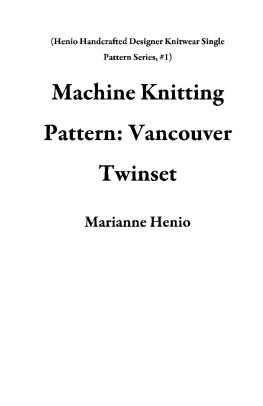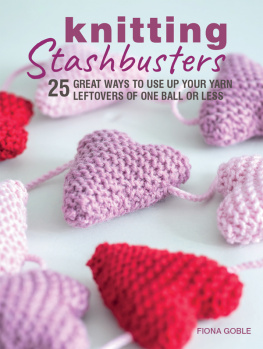Contents
LARK CRAFTS and the distinctive Lark logo are registered trademarks of Sterling Publishing Co., Inc.
Text 2019 Carol J. Sulcoski
Cover and photography 2019 Sterling Publishing Co., Inc.
All rights reserved. No part of this publication may be reproduced, stored in a retrieval system, or transmitted in any form or by any means (including electronic, mechanical, photocopying, recording, or otherwise) without prior written permission from the publisher.
ISBN 978-1-4547-1102-5
For information about custom editions, special sales, and premium and corporate purchases, please contact Sterling Special Sales at 800-805-5489 or .
larkcrafts.com
sterlingpublishing.com
Interior design by Nancy Singer
Cover design by Elizabeth Mihaltse Lindy
Image credits: Photography copyright Sterling Publishing except as noted: Alamy: Grant Heilman: (Corriedale)
For my aunt Jean, with gratitude for her love and support, and in memory of my aunts Carol and Martha, who are deeply missed
PREFACE
I wrote this book because when I was a newbie knitter, I didnt know how to pick out yarn. I would find a pattern to make and eagerly go yarn shopping, but once I got to the store, I had no idea where to start. After struggling, and asking for help, and making several projects that crashed and burned, I decided to learn about yarn substitution. It took me a while to figure out what I needed to know to substitute yarns successfully, but the knowledge that I gained has helped me ever since.
When I was asked to teach knitting classes many years ago, yarn substitution was the first topic that came to mind. Its a subject that knitters must understand to create projects they love. Its also a subject that isnt necessarily intuitive, especially for those of us who learned to knit informally. When I get to a certain point in class, I can see the light-bulb moment when my students realize how easy it is to substitute yarns once they have the necessary backgroundthe technical information that follows in this book. Read, pick out a few patterns youve always wanted to make, then go forth and substitute!
INTRODUCTION
The topic of yarn substitution is a big one, touching on many other subjects in the fiber world. After teaching about yarn substitution countless times, Ive developed my own approach to what can seem like a bewildering subject. Well begin by learning some essentials about yarn. Part I focuses on specific characteristics of yarn that will dramatically affect the substitution process: what yarns are made of (fiber content), how yarns are made (yarn construction), and what yarns look like (dyeing and other visual effects). Youll need a basic understanding of these subjects to differentiate among the many yarns available online and in your local yarn shop. The final chapter in the first section of the book is devoted to yarn classification, walking you through the yarn industrys system for organizing yarns into categories. At the end of this section, youll understand how and, more importantly, why yarns are sorted into these categories, and youll know how to select the yarn category that will work for the pattern you want to make.
Part II covers the actual process of yarn substitution, breaking it down into manageable steps. Ive also created a worksheet to help you stay organized while you collect all the information youll need to substitute successfully. You can copy the worksheet, then fill it out and take it with you when yarn shopping to ensure that you get exactly what you needwithout blowing your yarn budget on skeins that wont work for your project.
Part III contains a selection of basic garment designs. Each is a versatile, classic pattern that youll turn to time and time againthe perfect canvas on which to experiment with your own yarn substitutions. Ive included swatches and suggestions to help guide you when picking your own yarns or, perhaps, to open your eyes up to new possibilities.
Weve got a lot of important information to cover, so lets jump right in. The first step in successful yarn substitution awaits: learning about your yarn.
THE BIG THREE: STITCH DEFINITION, ELASTICITY, AND DRAPE
Lets start our look at yarn and fiber by considering three very important concepts that are commonly used to describe knitted fabric: stitch definition, elasticity, and drape. I refer to these qualities as the big three because they have such a significant impact on the appearance and behavior of knitted fabric. Well refer to the big three again and again in subsequent chapters as we examine fiber content, yarn construction, and other key topics.
STITCH DEFINITION
Stitch definition describes how easy or difficult it is to see the individual stitches in a piece of knitted fabric. Consider the two swatches on the next page (a) . The swatch on the left is knit in a yarn that has good stitch definition. You can see each individual stitch clearly, and you can see the details of the overall stitch pattern clearly, too.
The swatch on the right is knit in a yarn that does not have good stitch definition. Because the yarn is fuzzy, its difficult to see the individual stitches; the loose fibers around the surface of the strand get in the way. Those loose strands also make the overall stitch pattern difficult to see.

Whether a yarn has good or poor stitch definition is partly a function of how its made and partly a function of what its made from. Certain types of fiber, like mohair and angora, have an inherent tendency to look fuzzy, with fluffy loose fibers on the surface. (Youll often see these loose fibers called a halo; just as an angel is depicted with a ring of light around her head, so these yarns have a ring of hazy loose fibers around the yarn strand.) Other fibers have a smoother, sleeker surface, without short or loose fibers that obscure the stitches. When shopping for yarn, examine the individual strand to see how distinct its contours are: does it have a halo or a fluffy, fuzzy surface, or is the surface smooth and tidy?
















